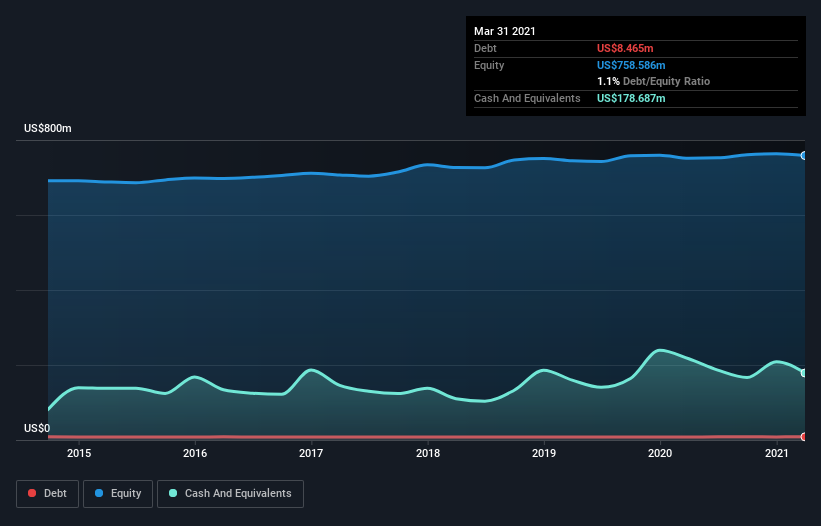
The external fund manager backed by Berkshire Hathaway's Charlie Munger, Li Lu, makes no bones about it when he says 'The biggest investment risk is not the volatility of prices, but whether you will suffer a permanent loss of capital.' It's only natural to consider a company's balance sheet when you examine how risky it is, since debt is often involved when a business collapses. As with many other companies Tootsie Roll Industries, Inc. (NYSE:TR) makes use of debt. But is this debt a concern to shareholders?
Why Does Debt Bring Risk?
Debt and other liabilities become risky for a business when it cannot easily fulfill those obligations, either with free cash flow or by raising capital at an attractive price. Ultimately, if the company can't fulfill its legal obligations to repay debt, shareholders could walk away with nothing. However, a more common (but still painful) scenario is that it has to raise new equity capital at a low price, thus permanently diluting shareholders. By replacing dilution, though, debt can be an extremely good tool for businesses that need capital to invest in growth at high rates of return. The first step when considering a company's debt levels is to consider its cash and debt together.
Check out our latest analysis for Tootsie Roll Industries
How Much Debt Does Tootsie Roll Industries Carry?
As you can see below, Tootsie Roll Industries had US$8.47m of debt, at March 2021, which is about the same as the year before. You can click the chart for greater detail. However, it does have US$178.7m in cash offsetting this, leading to net cash of US$170.2m.

How Strong Is Tootsie Roll Industries' Balance Sheet?
Zooming in on the latest balance sheet data, we can see that Tootsie Roll Industries had liabilities of US$65.9m due within 12 months and liabilities of US$154.5m due beyond that. Offsetting these obligations, it had cash of US$178.7m as well as receivables valued at US$36.4m due within 12 months. So its liabilities outweigh the sum of its cash and (near-term) receivables by US$5.35m.
This state of affairs indicates that Tootsie Roll Industries' balance sheet looks quite solid, as its total liabilities are just about equal to its liquid assets. So it's very unlikely that the US$2.24b company is short on cash, but still worth keeping an eye on the balance sheet. While it does have liabilities worth noting, Tootsie Roll Industries also has more cash than debt, so we're pretty confident it can manage its debt safely.
The modesty of its debt load may become crucial for Tootsie Roll Industries if management cannot prevent a repeat of the 34% cut to EBIT over the last year. When it comes to paying off debt, falling earnings are no more useful than sugary sodas are for your health. The balance sheet is clearly the area to focus on when you are analysing debt. But it is Tootsie Roll Industries's earnings that will influence how the balance sheet holds up in the future. So when considering debt, it's definitely worth looking at the earnings trend. Click here for an interactive snapshot.
Finally, a company can only pay off debt with cold hard cash, not accounting profits. Tootsie Roll Industries may have net cash on the balance sheet, but it is still interesting to look at how well the business converts its earnings before interest and tax (EBIT) to free cash flow, because that will influence both its need for, and its capacity to manage debt. During the last three years, Tootsie Roll Industries generated free cash flow amounting to a very robust 97% of its EBIT, more than we'd expect. That positions it well to pay down debt if desirable to do so.
Summing up
We could understand if investors are concerned about Tootsie Roll Industries's liabilities, but we can be reassured by the fact it has has net cash of US$170.2m. The cherry on top was that in converted 97% of that EBIT to free cash flow, bringing in US$57m. So we are not troubled with Tootsie Roll Industries's debt use. When analysing debt levels, the balance sheet is the obvious place to start. However, not all investment risk resides within the balance sheet - far from it. Be aware that Tootsie Roll Industries is showing 1 warning sign in our investment analysis , you should know about...
At the end of the day, it's often better to focus on companies that are free from net debt. You can access our special list of such companies (all with a track record of profit growth). It's free.
If you’re looking to trade Tootsie Roll Industries, open an account with the lowest-cost* platform trusted by professionals, Interactive Brokers. Their clients from over 200 countries and territories trade stocks, options, futures, forex, bonds and funds worldwide from a single integrated account. Promoted
Valuation is complex, but we're here to simplify it.
Discover if Tootsie Roll Industries might be undervalued or overvalued with our detailed analysis, featuring fair value estimates, potential risks, dividends, insider trades, and its financial condition.
Access Free AnalysisThis article by Simply Wall St is general in nature. It does not constitute a recommendation to buy or sell any stock, and does not take account of your objectives, or your financial situation. We aim to bring you long-term focused analysis driven by fundamental data. Note that our analysis may not factor in the latest price-sensitive company announcements or qualitative material. Simply Wall St has no position in any stocks mentioned.
*Interactive Brokers Rated Lowest Cost Broker by StockBrokers.com Annual Online Review 2020
Have feedback on this article? Concerned about the content? Get in touch with us directly. Alternatively, email editorial-team (at) simplywallst.com.
About NYSE:TR
Tootsie Roll Industries
Manufactures and sells confectionery products in the United States, Canada, Mexico, and internationally.
Flawless balance sheet average dividend payer.
Similar Companies
Market Insights
Community Narratives



